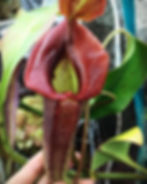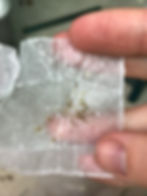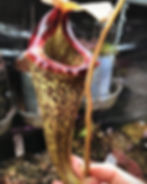Growing Nepenthes From Seed
- Carlton Carnivores
- Mar 25, 2023
- 5 min read
The first in a series to come: after getting your first carnivorous plant (or, really, after one starts trying to grow plants in general), many people rapidly look to trying to grow things from seeds, both for the potential challenges it can offer as well as the cheaper route for sometimes getting a lot of plants, as opposed to purchasing established seedlings or full-grown plants. It can be a fairly straightforward practice, in theory, but the practical application does have some quirks that need to be kept in mind. The first group we're visiting, is my favorite carnivore genus, the tropical pitchers Nepenthes!

The first thing you have to keep in mind, whether working with Nepenthes or any other group of plants from seed is: success is NEVER a guarantee. Even if you get all of your conditions right, treat the seeds properly, don't have any pest or fungal invasions, you still just might end up with occasions where the seeds you obtain just don't sprout. Whether this is because the plant they came from didn't put enough energy into the seeds to make good embryos, the embryos are just not quite developed right or sterile, or something happened to them in transit, failure is always a possibility and you can't be disappointed if it goes wrong.
Nepenthes seeds firstly are fairly small, strange looking things; most of the genus produces seeds that look like splinters of wood, with a tiny swollen central embryo and then two filamentous "wings" that stick out on either side, in nature helping them catch wind or water for dispersal. There are some exceptions, N. pervillei basically lacks these wings and some highland species see them highly reduced, likely to prevent them getting blown off the mountain peaks they need to remain on, but the overall structure is the same. Dioecious in nature, you must have both a pollen-producing male plant and an ovary-bearing female in bloom at the same time (or have pollen stored) in order to pollinate to set seeds, and the pods can take anywhere from 2-6 months to ripen.

Nepenthes seeds are designed to be surface germinators; whether or not they actually need light or benefit from it for germination is up for debate still, but when they are sown it should be done on the surface of a suitable soil. Milled long-fiber sphagnum (not live moss), well-rinsed peat or coconut coir, or similar mildly acidic, low-nutrient media are recommended. Seeds should be distributed evenly across the soil, try not to let too many overlap as they will compete with each other as they grow, and then they should be carefully watered in so they have good contact with the soil.
Next, HUMIDITY is something that is often lauded as highly necessary for seed germination and seedling survival...but it can be a danger as much if not more than a help. If you live somewhere where the humidity is already naturally at 60% or higher, or have a growing space that is, don't put anything over the seeds. If you are growing in a lower humidity area, putting a cover on can still be touchy, so instead sowing the seeds in a high-sided container that isn't filled all the way to the top can help. A relatively still boundary layer of air around the soil will maintain all the humidity then that the seeds need to avoid drying out, as long as the soil is also kept properly moist (and preferably moist, not soaking wet most of the time). Putting covers over the seeds to increase humidity results in stagnant air if not regularly removed, and can invite the growth of bacterial, algal, and fungal blooms that can kill healthy seeds. Seeds and seedlings are both relatively vulnerable, small and thin and as such easily attacked by pathogens, so preventing conditions that can produce them is important. Keeping the soil clean is also helpful; while it is often likely that some algae and harmless detritivore fungus growth will appear and this isn't a serious issue, significant blooms of these or the gooey slime molds that also sometimes come in can damage the seeds and prevent them from germinating properly. Removing patches of dense growth of this, or treating with light applications of hydrogen peroxide can help keep this at bay. Also, keep an eye out for and remove fungus gnats and their larvae if seen; while harmless to large plants, the gnat larvae will decimate seedlings.
Once seeds are sown and the soil is correctly kept moist, keep the seeds in the conditions that the adult plants want; highland seeds can sometimes be started in warmer conditions as this may speed up germination, but for the most part, put highlanders in cool conditions, lowland seeds in warm conditions, and decent lighting, no heavy shade. Then this becomes a game of waiting. Nepenthes seeds are not for those in a hurry; some lowland species and hybrids can sometimes start sprouting within a couple of weeks (weeks, not days, still not as fast as your average veggie seedlings), but many, especially touchy highlanders, can take several months, or even over a year in some cases, to start sprouting. The fresher the seeds, the more likely there will be healthy and faster germination as well; many Nepenthes seeds are now being proven to be displaying the ability to be semi-dry stored in refrigerator conditions, but otherwise lose viability quickly and even in the fridge seem to develop slower sprouting and lower, more erratic germination capacity in my experience. Once sown, don't lose hope until you see everything being broken down by fungus or you've waited 18 months or so.
Seedlings are tiny, starting out as two little cotyledons that spring up from the seed casing and one small root that begins forming the taproot system these plants develop with age (some more than others). They cannot dry out, and should be given enough light to maintain good color and health, but not full sunlight which is likely to burn them. The first true leaf may take a few days, or several weeks to develop depending on the species, and will bear the first pitcher on it as well. If you maintain good colonies of springtails in your soils, these can feed the small pitchers, otherwise light spritzing of foliar fertilizers can help boost their growth. Caution however, as if you get more fertilizer on the soil than you do the seedlings, you're liable to trigger those algal and fungal blooms that cause issues for seedlings, or trigger rapid growth of moss spores that can overgrow the small seedlings. As with everything else when dealing with Nepenthes, going from those first true leaves to even a really recognizable structure on a two or three inch seedling can take a matter of months to years; patience is the key with these at all times.

As soon as the seedlings are large enough to work with, half an inch or so across or more, if they were sown relatively densely it's recommended to space them out. Sowing the seeds on a realtively loose, disconnected soil like coir or peat helps with this, or very well-milled sphagnum, as the roots will often be far larger than you might think (the kampotiana seedlings shown above even at that size already have taproots and side shoots several inches long). Do your very best not to break any roots, and plant them gently preferably into their own separate pots; any root disturbance will slow down the plants and for sensitive species may take months to reset and start growing well again. From this point on, once again it's a game of patience: those inch-wide seedlings may take 2-3 years to mature if they're a fast-growing lowland species, but many of the highlanders or more picky lowlanders can take 5, 7, 10+ years to reach maturity. However as each seedling has its own unique genetic code, and as Nepenthes being dioecious require outcrossing every time they reproduce, you're guaranteed to have individuals that are unique, in color, shape, and vigor. They are a full gauntlet of trials testing your patience, but patience can pay off greatly with spectacular plants in the end that you can be sure no one else has.

